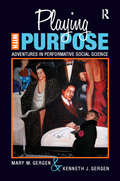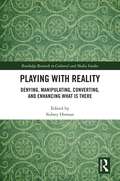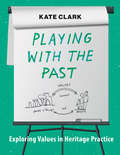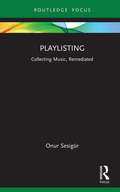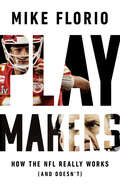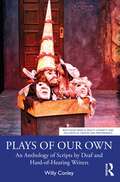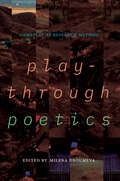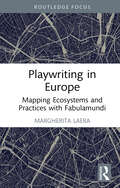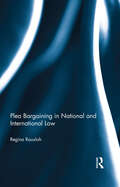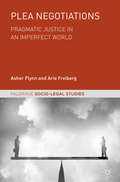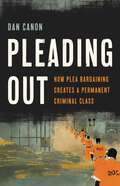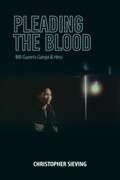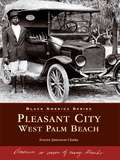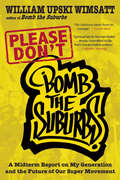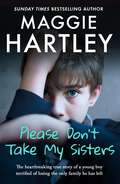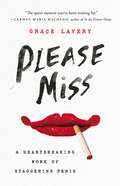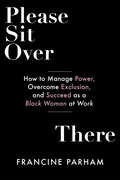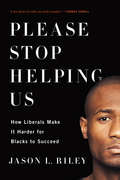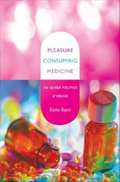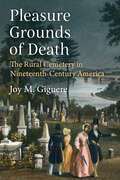- Table View
- List View
Playing with Purpose: Adventures in Performative Social Science (Writing Lives: Ethnographic Narratives #12)
by Mary M Gergen Kenneth J GergenDistilling decades of work spanning their prestigious careers, Mary M. and Kenneth J. Gergen make a strong case for enriching the social sciences through performative work. They present a unique exploration of the origins of performative social science and provide an intellectually rich overview of its significance in the field, as well as its evolving potential. Many of their own performance pieces are included in the volume. The authors envision a broadening of the social sciences, making it more accessible to non-experts and opening up new dialogues between society and science—and changing the world in the process. Social scientists and researchers will gain a valuable new perspective from this insightful tome.
Playing with Reality: Denying, Manipulating, Converting, and Enhancing What Is There (Routledge Research in Cultural and Media Studies)
by Sidney HomanThis volume explores how and why we deny, or manipulate, or convert, or enhance reality. Finding it important to come to terms with reality, with what is there before us, and, with reality however defined, to live responsibly, this collection takes a truly multidisciplinary approach to examining the idea that history, the truth, facts, and the events of the present time can be refashioned as prismatic, theatrical, something we can play with for agendas either noble or ignoble. An international team of contributors considers the issue of how and why, in dealing what is there before us, we play with reality by employing theatre, fiction, words, conspiracy theories, alternate realities, scenarios, and art itself. Chapters delve into issues of fake news, propaganda, virtual reality, theatre as real life, reality TV, and positive ways of refashioning and enhancing your own reality. Drawing on examples from film studies to sociology, from the social sciences to medicine, this volume will appeal to scholars and upper-level students in the areas of communication and media studies, comparative literature, film studies, economics, English, international affairs, journalism, philosophy, psychology, sociology, and theatre.
Playing with Videogames
by James NewmanPlaying with Videogames documents the richly productive, playful and social cultures of videogaming that support, surround and sustain this most important of digital media forms and yet which remain largely invisible within existing studies. James Newman details the rich array of activities that surround game-playing, charting the vibrant and productive practices of the vast number of videogame players and the extensive 'shadow' economy of walkthroughs, FAQs, art, narratives, online discussion boards and fan games, as well as the cultures of cheating, copying and piracy that have emerged. Playing with Videogames offers the reader a comprehensive understanding of the meanings of videogames and videogaming within the contemporary media environment.
Playing with the Past: Exploring Values in Heritage Practice
by Kate ClarkHeritage is all around us, not just in monuments and museums, but in places that matter, in the countryside and in collections and stories. It touches all of us. How do we decide what to preserve? How do we make the case for heritage when there are so many other priorities? Playing with the Past is the first ever action-learning book about heritage. Over eighty creative activities and games encompass the basics of heritage practice, from management and decisionmaking to community engagement and leadership. Although designed to ‘train the trainers’, the activities in the book are relevant to anyone involved in caring for heritage.
Playlisting: Collecting Music, Remediated (Routledge Focus on Digital Media and Culture)
by Onur SesigürThis book examines the collection and curation of music, and the way digital streaming services are transforming the way we engage with the media. The study foregrounds personal digital curation techniques, rather than algorithms or technology, to acknowledge the sustaining human agency involved in playlisting. The author looks at Digital Service Providers such as Spotify, Apple and Deezer, which offer their users not just access to large collections of music, but also the opportunity to create and maintain personalised consumption subsets such as playlists. Positioning these current playlisting practices as a remediation of significant cultural practices of the 20th century – such as collecting records and mix-taping – the book highlights the continuity of culture through media change, and the implications for concepts of self and identity, society and sharing. Shedding new light on this contemporary cultural phenomenon, this book will be an important read for scholars who are interested in the area of digital music from different disciplines such as communication, digital humanities and social sciences in fields of media studies, digital cultures, personal information management, digital curation and popular music.
Playmakers: How the NFL Really Works (And Doesn't)
by Mike FlorioThe story of a modern NFL that can&’t get out of its own way—and can&’t stop making moneyIn recent decades, the NFL has simultaneously become an athletic, financial, and cultural powerhouse—and a League that can&’t seem to go more than a few weeks without a scandal. Whether it&’s about domestic violence, performance-enhancing drugs, racism, or head trauma, the NFL always seems to be in some kind of trouble. Yet no matter the drama, the TV networks keep showing games, the revenue keeps rising, and the viewers keep tuning in.How can a sports league—or any organization—operate this way? Why do the negative stories keep happening, and why don&’t they ever seem to affect the bottom line? In this wide-ranging book, Mike Florio takes readers from the boardroom to the locker room, from draft day to the Super Bowl, answering these questions and more, and showing what really goes on in the sport that America can&’t seem to quit.Known for his constant stream of new information and incisive commentary, Florio delivers again in this book. With new insights and reporting on scandals past and present, this book will be the talk of the League—whether the League likes it or not.
Plays of Our Own: An Anthology of Scripts by Deaf and Hard-of-Hearing Writers (Routledge Series in Equity, Diversity, and Inclusion in Theatre and Performance)
by Willy ConleyPlays of Our Own is the first anthology of its kind containing an eclectic range of plays by Deaf and hard-of-hearing writers. These writers have made major, positive contributions to world drama or Deaf theatre arts. Their topics range from those completely unrelated to deafness to those with strong Deaf-related themes such as a dreamy, headstrong girl surviving a male-dominated world in Depression-era Ireland; a famous Spanish artist losing his hearing while creating his most controversial art; a Deaf African-American woman dealing with AIDS in her family; and a Deaf peddler ridiculed and rejected by his own kind for selling ABC fingerspelling cards. The plays are varied in style – a Kabuki western, an ensemble-created variety show, a visual-gestural play with no spoken nor signed language, a cartoon tragicomedy, historical and domestic dramas, and a situation comedy. This volume contains the well-known Deaf theatre classics, My Third Eye and A Play of Our Own. At long last, directors, producers, Deaf and hearing students, professors, and researchers will be able to pick up a book of "Deaf plays" for production consideration, Deaf culture or multicultural analysis, or the simple pleasure of reading.
Playthrough Poetics: Gameplay as Research Method
by Milena DroumevaGame streamers and live commentators are producing increasingly comprehensive analyses of gameplay, yet scholarship still tends to flatten the experiential media of video games into text for close reading. By shifting focus toward the immersiveness of video games, Playthrough Poetics makes the case for gameplay as a necessary, alternate method. Contributors to this volume engage widely with the activity of play through autoethnographies, meta-analyses of self-broadcasting, new procedural methods like gamespace soundwalking, as well as the affective aspects of games research. In doing so, they model new possibilities for academic players and gamers alike. Rigorous scholarship meets cultural practice in this innovative, multi-modal edited collection that includes video essays and offers transcripts of the playthroughs themselves. Readers (and viewers) will come away with a toolkit of models, case studies, and conceptual frameworks for analyzing video games through gameplay. This volume is a fresh return to the joy of play: the poetics of games as contemporary forms of storytelling and interactivity. With contributions from Ashlee Bird, Brandon Blackburn, Milena Droumeva, Kishonna Gray, Robyn Hope, Ben Scholl, Maria Sommers, Ashlyn Sparrow, Christine Tran, and Aaron Trammell.
Playwriting in Europe: Mapping Ecosystems and Practices with Fabulamundi (Routledge Advances in Theatre & Performance Studies)
by Margherita LaeraThis book maps contemporary playwriting and theatre translation practices and ecologies in the European continent. Whether you are a scholar researching contemporary drama and translation, or a theatre practitioner looking for ways to navigate theatrical conventions in other countries, this book is for you. Through questionnaires and one-to-one interviews with key stakeholders, Dr Laera collects qualitative and quantitative data about how each national theatre culture supports living dramatists, what conventions drive the production and translation (or lack thereof) of contemporary plays, and what perceptions are held by gatekeepers, theatre-makers and other cultural operators about the theatre system in which they work. Through country-by-country descriptions and analyses; interviews with playwrights, translators, directors and gatekeepers; a list of key facts and best practices; and a rigorous assessment of its methodologies, this volume is indispensable for those interested in contemporary European theatre practice.
Plea Bargaining in National and International Law: A Comparative Study
by Regina RauxlohPlea bargaining is one of the most important and most discussed issues in modern criminal procedure law. Based on historical and comparative legal research, the author has analysed the wide-spread use of plea bargaining in different criminal justice systems. The book sets out in-depth studies of consensual case dispositions in the UK, examining how plea bargaining has developed and spread in England and Wales. It also goes on to discusses in detail the problems that this practise poses for the rule of law by avoiding procedural safe-guards. The book draws on empirical research in its examination of the absence of informal settlements in the former GDR, offering a unique insight into criminal procedure in a socialist legal system that has been little studied. Drawing on her research findings, the author goes on to discuss the extent to which plea bargaining should be developed in the International Criminal Court in The Hague, as the question of this practise is set to be one of the seminal debates in the development of international criminal procedures in the new International Criminal Court. Plea Bargaining in National and International Law will be of particular interest to academics and students of international criminal law, criminal procedures and comparative law.
Plea Negotiations: Pragmatic Justice in an Imperfect World (Palgrave Socio-Legal Studies)
by Asher Flynn Arie FreibergDespite a popular view that trials are the focal point of the criminal justice process, in reality, the most frequent way a criminal matter resolves is not through a fiercely fought battle between state and defendant, but instead through a process of negotiation between the prosecution and defence, resulting in a defendant pleading guilty in exchange for agreed concessions from the prosecution. This book presents an original empirical case-study of plea negotiations drawing upon interviews with legal actors and an analysis of defence practitioner case files, to shine light on the processes and ways in which an agreed outcome is reached in criminal prosecutions, within the setting of a jurisdiction, like many others world-wide, which is suffering major shifts in state resources. Plea negotiations, also referred to as “plea bargaining”, “negotiated guilty pleas” and “negotiated resolutions” are neither an alloyed benefit nor a detriment for defendants, victims or the criminal justice system generally, and like all compromises, this book shows how the perfect “justice” outcome gives way to the good, or just the reasonably acceptable justice outcome.
Plea for the Animals: The Moral, Philosophical, and Evolutionary Imperative to Treat All Beings with Compassion
by Matthieu RicardA powerful and wide-ranging indictment of the treatment of animals by humans--and an eloquent plea for animal rights. Every cow just wants to be happy. Every chicken just wants to be free. Every bear, dog, or mouse experiences sorrow and feels pain as intensely as any of us humans do. In a compelling appeal to reason and human kindness, Matthieu Ricard here takes the arguments from his best-sellers Altruism and Happiness to their logical conclusion: that compassion toward all beings, including our fellow animals, is a moral obligation and the direction toward which any enlightened society must aspire. He chronicles the appalling sufferings of the animals we eat, wear, and use for adornment or "entertainment," and submits every traditional justification for their exploitation to scientific evidence and moral scrutiny. What arises is an unambiguous and powerful ethical imperative for treating all of the animals with whom we share this planet with respect and compassion.
Pleading Out: How Plea Bargaining Creates a Permanent Criminal Class
by Dan CanonA blistering critique of America&’s assembly-line approach to criminal justice and the shameful practice at its core: the plea bargain Most Americans believe that the jury trial is the backbone of our criminal justice system. But in fact, the vast majority of cases never make it to trial: almost all criminal convictions are the result of a plea bargain, a deal made entirely out of the public eye. Law professor and civil rights lawyer Dan Canon argues that plea bargaining may swiftly dispose of cases, but it also fuels an unjust system. This practice produces a massive underclass of people who are restricted from voting, working, and otherwise participating in society. And while innocent people plead guilty to crimes they did not commit in exchange for lesser sentences, the truly guilty can get away with murder. With heart-wrenching stories, fierce urgency, and an insider&’s perspective, Pleading Out exposes the ugly truth about what&’s wrong with America&’s criminal justice system today—and offers a prescription for meaningful change.
Pleading the Blood: Bill Gunn's <i>Ganja & Hess</i> (Studies in the Cinema of the Black Diaspora)
by Christopher SievingThe definitive look at one of the most important Black art films and original filmmakers of the 1970s.Bill Gunn's Ganja & Hess (1973) has across the decades attained a sizable cult following among African American cinema devotees, art house aficionados, and horror fans, thanks to its formal complexity and rich allegory. Pleading the Blood is the first full-length study of this cult classic. Ganja & Hess was withdrawn almost immediately after its New York premiere by its distributor because Gunn's poetic re-fashioning of the vampire genre allegedly failed to satisfy the firm's desire for a by-the-numbers "blaxploitation" horror flick for quick sell-off in the urban market. Its current status as one of the classic works of African American cinema has recently been confirmed by the Blu-ray release of its restored version, by its continued success in screenings at repertory houses, museums, and universities, and by an official remake, Da Sweet Blood of Jesus (2014), directed by Spike Lee, one of the original picture's longtime champions.Pleading the Blood draws on Gunn's archived papers, screenplay drafts, and storyboards, as well as interviews with the living major creative participants to offer a comprehensive, absorbing account of the influential movie and its highly original filmmaker.
Pleasant City, West Palm Beach
by Everee Jimerson ClarkePleasant City, a neighborhood of West Palm Beach, Florida, is the oldest African-American community in Palm Beach County. The first black settlers came to a place called the Styx--later owned by white millionaires who then rented their backyards to black workers--to work on the railroad and Henry Flagler's hotel and mansion. Forced out when the land became valuable, the blacks purchased land and settled Pleasant City. Pleasant City was marketed as a "High Class Colored Subdivision" in 1913, and many of the pioneers still have descendants in the area today.
Please Don't Bomb the Suburbs: A Midterm Report on My Generation and the Future of Our Super Movement
by William Upski WimsattHere's what the critics have to say about William Upski Wimsatt's previous work:"Spiritual heir to Norman Mailer."-The Atlantic"Wimsatt's charisma stems from his courage."-Cornel West"Bomb the Suburbs and No More Prisons are cult classics deftly reflecting the hip-hop generation's maturation."-Miami New Times"A refreshing voice for Generation X."-Library Journal"Ahead of the curve."-SpinAs a potty-mouthed graffiti writer from the South Side of Chicago, William Upski Wimsatt electrified the literary and hip-hop world with two of the most successful underground classic books in a generation, Bomb the Suburbs (1994) and No More Prisons (1999), which, combined, sold more than ninety thousand copies.In Please Don't Bomb the Suburbs, Wimsatt weaves a first-person tour of America's cultural and political movements from 1985-2010. It's a story about love, growing up, a generation coming of age, and a vision for the movement young people will create in the new decade. With humor, storytelling, and historical insight, Wimsatt lays out a provocative vision for the next twenty-five years of personal and historical transformation. Never heard of Billy Wimsatt before? Your life just got better.William Upski Wimsatt is the author of Bomb the Suburbs and No More Prisons. A maverick graffiti artist, journalist, and political and philanthropic organizer, Wimsatt has appeared in dozens of publications and is a popular speaker at colleges and conferences. He founded the League of Young Voters, worked for Barack Obama in Ohio, and co-organized the first-ever briefing of social justice artists with the White House. He was honored as a "visionary" by Utne Reader and included in The Source's "Power 30" list. He lives in Brooklyn.
Please Don't Sit on My Bed in Your Outside Clothes: Essays
by Phoebe RobinsonWith sharp, timely insight, pitch-perfect pop culture references, and her always unforgettable voice, New York Times bestselling author, comedian, actress, and producer Phoebe Robinson is back with her most must-read book yet. In her brand-new collection, Phoebe shares stories that will make you laugh, but also plenty that will hit you in the heart, inspire a little bit of rage, and maybe a lot of action. That means sharing her perspective on performative allyship, white guilt, and what happens when white people take up space in cultural movements; exploring what it&’s like to be a woman who doesn&’t want kids living in a society where motherhood is the crowning achievement of a straight, cis woman&’s life; and how the dire state of mental health in America means that taking care of one&’s mental health—aka &“self-care&”—usually requires disposable money. She also shares stories about her mom slow-poking before a visit with Mrs. Obama, the stupidly fake reassurances of zip-line attendants, her favorite things about dating a white person from the UK, and how the lack of Black women in leadership positions fueled her to become the Black lady boss of her dreams. By turns perceptive, laugh-out-loud funny, and heartfelt, Please Don&’t Sit on My Bed in Your Outside Clothes is not only a brilliant look at our current cultural moment, it's also a collection that will stay with readers for years to come.
Please Don't Take My Sisters: The heartbreaking true story of a young boy terrified of losing the only family he has left (A Maggie Hartley Foster Carer Story)
by Maggie HartleyThree-year-old Lexie, five-year-old Amelie and thirteen-year-old Leo come to Maggie after Leo confesses to a teacher that his mother's addiction problems and her latest violent relationship has left him as the sole carer to his younger sisters. Maggie welcomes the three children into her home, and is touched by the gentle care Leo shows to the two little girls. It is clear that Lexie and Amelie adore their big brother, and rely on him for comfort and reassurance. But Leo has experienced the neglect and abuse of his mother and her partner for far longer than his sisters, and is struggling with an eating disorder and showing signs of OCD.When Social Services begin to look at adoptive families for the children, Maggie is horrified when they suggest that the two angelic little girls will have a much better chance of being adopted without their damaged older brother. Knowing the impact that losing his sisters forever will have on vulnerable Leo, they face the ultimate dilemma. Should the children stay together and dash the hope of them ever having a forever family? Or do they sacrifice the close bond between the siblings to give the girls a chance to be adopted?
Please Miss: A Heartbreaking Work of Staggering Penis
by Grace Lavery&“The queer memoir you&’ve been waiting for&”—Carmen Maria MachadoGrace Lavery is a reformed druggie, an unreformed omnisexual chaos Muppet, and 100 percent, all-natural, synthetic female hormone monster. As soon as she solves her &“penis problem,&” she begins receiving anonymous letters, seemingly sent by a cult of sinister clowns, and sets out on a magical mystery tour to find the source of these surreal missives. Misadventures abound: Grace performs in a David Lynch remake of Sunset Boulevard and is reprogrammed as a sixties femmebot; she writes a Juggalo Ghostbusters prequel and a socialist manifesto disguised as a porn parody of a quiz show. Or is it vice versa? As Grace fumbles toward a new trans identity, she tries on dozens of different voices, creating a coat of many colors.With more dick jokes than a transsexual should be able to pull off, Please Miss gives us what we came for, then slaps us in the face and orders us to come again.
Please Sit Over There: How to Manage Power, Overcome Exclusion, and Succeed as a Black Woman at Work
by Francine ParhamThe key to your career advancement is understanding how power works--who has it, where it hides, and how it's used. Please Sit Over There teaches Black women the career skills they need to navigate an uneven playing field and achieve long-lasting professional success.Black women continuously navigate systems that were never intended for them while playing by a set of rules they never agreed to or were ever trained for.In this book, Francine Parham shares her knowledge as a Black woman and a former global executive of two major corporations on how to move up in the workplace while maintaining a sense of sanity. The key skill--one that Black women are rarely taught--is understanding the power dynamics within your organization and learning how to shift the power to your advantage. Parham shows how to use your voice, strategically build the right relationships, and support others once you have achieved a powerful position--tools any woman can use to increase her power and ensure a successful, fulfilling career.Parham says Black women are already empowered; there is no shortage of qualified professional Black women in the talent pipeline. But it does not feel empowering when organizations force Black women to work every day to overcome biases, discriminatory institutional practices, and unwritten rules of power at play that hinder their career development and professional advancement. Please Sit Over There honors the painstaking work being undertaken to deconstruct broken institutions and demonstrates how Black women can achieve their goals while those institutions still exist-effectively opening doors for all women of color.
Please Stop Helping Us
by Jason L. RileyWhy is it that so many efforts by liberals to lift the black underclass not only fail, but often harm the intended beneficiaries?In Please Stop Helping Us, Jason L. Riley examines how well-intentioned welfare programs are in fact holding black Americans back. Minimum-wage laws may lift earnings for people who are already employed, but they price a disproportionate number of blacks out of the labor force. Affirmative action in higher education is intended to address past discrimination, but the result is fewer black college graduates than would otherwise exist. And so it goes with everything from soft-on-crime laws, which make black neighborhoods more dangerous, to policies that limit school choice out of a mistaken belief that charter schools and voucher programs harm the traditional public schools that most low-income students attend.In theory these efforts are intended to help the poor-and poor minorities in particular. In practice they become massive barriers to moving forward.Please Stop Helping Us lays bare these counterproductive results. People of goodwill want to see more black socioeconomic advancement, but in too many instances the current methods and approaches aren't working. Acknowledging this is an important first step.
Pleasure Activism: The Politics Of Feeling Good (Emergent Strategy Ser.)
by Leah Lakshmi Piepzna-Samarasinha Adrienne Maree Brown Favianna RodriguezHow do we make social justice the most pleasurable human experience? How can we awaken within ourselves desires that make it impossible to settle for anything less than a fulfilling life? Author and editor adrienne maree brown finds the answer in something she calls "pleasure activism," a politics of healing and happiness that explodes the dour myth that changing the world is just another form of work. Drawing on the black feminist tradition, she challenges us to rethink the ground rules of activism. Her mindset-altering essays are interwoven with conversations and insights from other feminist thinkers, including Audre Lorde, Joan Morgan, Cara Page, Sonya Renee Taylor, and Alexis Pauline Gumbs. Together they cover a wide array of subjects--from sex work to climate change, from race and gender to sex and drugs--building new narratives about how politics can feel good and how what feels good always has a complex politics of its own.
Pleasure Consuming Medicine: The Queer Politics of Drugs
by Kane RaceOn a summer night in 2007, the Azure Party, part of Sydney's annual gay and lesbian Mardi Gras, is underway. Alongside the party outfits, drugs, lights, and DJs is a volunteer care team trained to deal with the drug-related emergencies that occasionally occur. But when police appear at the gates with drug-detecting dogs, mild panic ensues. Some patrons down all their drugs, heightening their risk of overdose. Others try their luck at the gates. After twenty-six attendees are arrested with small quantities of illicit substances, the party is shut down and the remaining partygoers disperse into the city streets. For Kane Race, the Azure Party drug search is emblematic of a broader technology of power that converges on embodiment, consumption, and pleasure in the name of health. In Pleasure Consuming Medicine, he illuminates the symbolic role that the illicit drug user fulfills for the neoliberal state. As he demonstrates, the state's performance of moral sovereignty around substances designated "illicit" bears little relation to the actual dangers of drug consumption; in fact, it exacerbates those dangers. Race does not suggest that drug use is risk-free, good, or bad, but rather that the regulation of drugs has become a site where ideological lessons about the propriety of consumption are propounded. He argues that official discourses about drug use conjure a space where the neoliberal state can be seen to be policing the "excesses" of the amoral market. He explores this normative investment in drug regimes and some "counterpublic health" measures that have emerged in response. These measures, which Race finds in certain pragmatic gay men's health and HIV prevention practices, are not cloaked in moralistic language, and they do not cast health as antithetical to pleasure.
Pleasure Grounds of Death: The Rural Cemetery in Nineteenth-Century America
by Joy M. GiguereRural cemeteries—named for their expansive, picturesque landscape design rather than location—were established during the middle decades of the nineteenth century in the United States. An instant cultural phenomenon, Mount Auburn Cemetery in Cambridge, Massachusetts, was the nation’s first such burial ground to combine the functions of the public park and the cemetery, becoming a popular place to picnic and go for strolls even for people who didn’t have graves to visit. It sparked a nationwide movement in which communities sought to establish their own cities of the dead. Pleasure Grounds of Death considers the history of the rural cemetery in the United States throughout the duration of the nineteenth century as not only a critical cultural institution embedded in the formation of community and national identities, but also as major sites of contest over matters of burial reform, taste and respectability, and public behavior; issues concerning race, class, and gender; conflicts over the burial of the Civil War dead and formation of postwar memory; and what constituted the most appropriate ways to structure the landscape of the dead in a modern and progressive society. As cultural landscapes that served the needs of the living as well as the dead, rural cemeteries offer a mirror for the transformations and conflicts taking place throughout the nineteenth century in American society.
Pleasure Wars: Victoria to Freud)
by Peter GayA master historian shows us a new side of the Victorian Era--the role of the Bourgeois as reactionaries, revolutionaries, and middle-of-the-roaders in the passage of high culture toward modernism. The Victorians in this richly peopled narrative maneuvered through decades marked by frequent shifts in taste, some seeking safety in traditional styles, others drawn to the avant-garde of artists, composers, and writers. Peter Gay's panoramic survey offers a fresh view of the ideas and sensibilities that dominated Victorian culture.
